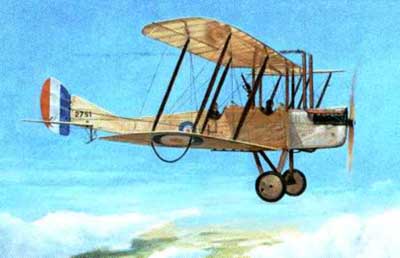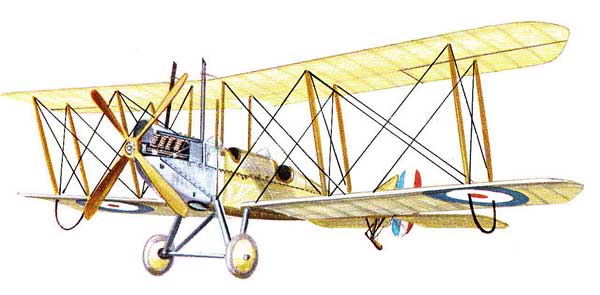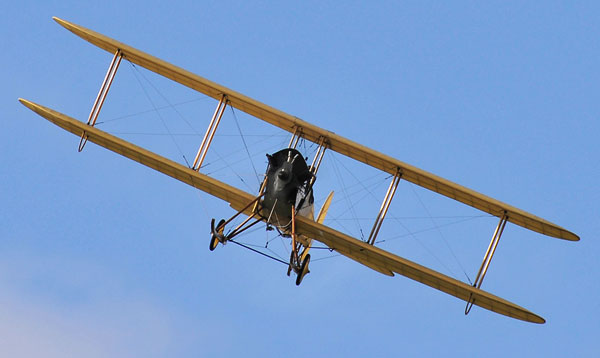Royal Aircraft Factory B.E.2 WWI British Reconnaissance/Bomber

The Royal Aircraft Factory B.E.2 was designed with emphasis on stability, which made it particularly suitable for reconnaissance for the British Army on the Western Front. In mid-1915 the nature of air war changed with the arrival of the agile Fokker Eindecker with its forward-firing guns. Reconnaissance and bomber aircraft were shot from the skies, and the RAF B.E.2s suffered the worst losses. Reconnaissance aircraft soon needed large escorts, but if a B.E.2 was caught by a fighter, usually all it had to defend itself was pistols or rifles fired by the observer. With the observer in the front, no effective machine-gun arrangement was possible.
Continued employment (and production) of R.A.F. B.E.2s in an increasingly dangerous environment led to claims in Parliament that young men were being sent out to be murdered. By 1917 most B.E.2s were found more suitable employment as trainers.
R.A.F. B.E.2

 Britain, like other countries, was fielding transitional aircraft for the first few months of the war, with pioneer designs from the days before aerial war had become a matter of real experience. Among the aircraft already in production at the outbreak of war were biplanes of the B.E. series, built by the Royal Aircraft Factory (R.A.F.).
Britain, like other countries, was fielding transitional aircraft for the first few months of the war, with pioneer designs from the days before aerial war had become a matter of real experience. Among the aircraft already in production at the outbreak of war were biplanes of the B.E. series, built by the Royal Aircraft Factory (R.A.F.).
Slow, very lightly armed, and not very manoeuvrable, these aircraft, which dated from 1912, were often at a disadvantage against more modern adversaries. The series had started with the B.E.1 designed by Geoffrey de Havilland and F. M. Green, which had flown for the first time on 1st January 1912. In the following month the B.E.2 had appeared, proving superior to other aircraft which were being tested by the Army at the time. It had managed to break the British altitude record at 10,560 feet. The beginning of war found a new model in service in three squadrons of the Royal Flying Corps, with an improved skin and with a better fuel system; this was the B.E.2a.
These aircraft were widely used for reconnaissance and as bombers, in the latter role carrying a 100lb bomb or three smaller bombs. The B.E.2, however, was not armed with a machine gun and during its operational service in France showed itself to be easy prey for the more powerful and manoeuvrable German fighters. Later on came the B.E.8, developed in 1913 with a slightly more powerful rotary engine. Their operational value was limited by the fact that these planes could only carry 100 lb of bombs with the pilot as the only crew. The bombload was even smaller if a two-man crew was carried. Defense was entrusted to the observer, who used a pistol or rifle.
The R.A.F. (Royal Aircraft Factory) R.E.5 biplane was similarly a basic reconnaissance plane. It appeared in 1914 with two squadrons of the Royal Flying Corps. While not famed for its maneuverability, this plane too was unarmed: the observer carried personal weapons, and there was provision for a maximum load of 60 lb of small bombs. The R.E.5, soon hopelessly out of its depth with improving enemy aircraft, had to be withdrawn and used at home for experimental flights. One R.E.5, converted to a single-seater and given greater wingspan, reached an altitude of 17,000 feet in July 1914. Another was used to test a new 335 lb bomb. Maneuverability and speed, which had been amply demonstrated in competitions, were the main characteristics of the Sop with Tabloid, four of which had been sent to France shortly after the outbreak of war. Production of the military version of the aircraft which had won the 1914 Schneider trophy had started in the spring, and the total produced reached 40.
The aircraft turned out to be of little use as a warplane, still lacking adequate armament. One pilot of a Tabloid succeeded in bringing down a German aeroplane by circling round it and throwing steel darts at it, but there are no records of significant performance in aerial combat. It was later used as a light bomber, although the most it could carry was a small load of 20 lb bombs.
Very similar to the Tabloid, although generally inferior, was another contemporary aeroplane, the Martinsyde S.1, which served on the Western front as a fast reconnaissance plane. Delivered in small numbers to each squadron, it remained in service until the summer of 1915. Only 60 of this aircraft were built.



Specifications of the Royal Aircraft Factory B.E.2
 |
Crew: Two, pilot and observer Length: 27 ft 3 in Wingspan: 37 ft Height: 11 ft 1 in Wing area: 398 ft² Empty weight: 1,366 lb Max takeoff weight: 2,138 lb Powerplant: 1× RAF 1a air cooled V-8 engine, 90 hp Performance Maximum speed: 72 mph Range: 200 miles Service ceiling: 10,000 ft Rate of climb: 1,066 ft/min Armament 1 x .303 in (7.7 mm) Lewis gun for observer 224 lb of bombs |
 |
|||
| A: The pilot's cockpit had no blind-flying instruments, so entering a cloud was often a fatal mistake. Many B.E.s went into spins from which they could not recover. | B: Over 3200 B.E.2s were built by over 20 contractors in a variety of models with few visible differences. The last model was about 3mph faster than the first. | C: Lateral control was effected by warping the wings, which was fine for sedate turns but not for evading enemy fighters or anti-aircraft fire. | D: The sedate, stable and very slow B.E.2 made a fine photographic platform in conditions of air superiority, but when Germany fielded the first fighting scouts, the RFC's crews were slaughtered. |
 |
Royal Aircraft Factory(R.A.F.) B.E.2c crashed in Egypt, date unknown. |

